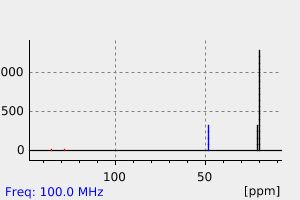DICE | 65785-45-7
中文名称
——
中文别名
——
英文名称
DICE
英文别名
(1-Chloro-2-methyl-propenyl)-diisopropyl-amine;1-chloro-N,N-diisopropyl-2-methylprop-1-en-1-amine;1-chloro-2-methyl-N,N-di(propan-2-yl)prop-1-en-1-amine
CAS
65785-45-7
化学式
C10H20ClN
mdl
MFCD03425853
分子量
189.728
InChiKey
UTWJPDIBWGZIJV-UHFFFAOYSA-N
BEILSTEIN
——
EINECS
——
-
物化性质
-
计算性质
-
ADMET
-
安全信息
-
SDS
-
制备方法与用途
-
上下游信息
-
文献信息
-
表征谱图
-
同类化合物
-
相关功能分类
-
相关结构分类
物化性质
-
沸点:235.2±23.0 °C(Predicted)
-
密度:0.920±0.06 g/cm3(Predicted)
计算性质
-
辛醇/水分配系数(LogP):4.3
-
重原子数:12
-
可旋转键数:3
-
环数:0.0
-
sp3杂化的碳原子比例:0.8
-
拓扑面积:3.2
-
氢给体数:0
-
氢受体数:1
反应信息
-
作为反应物:描述:DICE 生成 N,N-二异丙基异丁胺参考文献:名称:MUNYEMANA, FRANCOIS;FRISQUE-HESBAIN, ANNE-MARIE;DEVOS, ALAIN;GHOSEZ, LEON, TETRAHEDRON LETT., 30,(1989) N3, C. 3077-3080摘要:DOI:
-
作为产物:描述:参考文献:名称:用卤素取代羟基的温和方法:3. α-卤代烯胺对烯丙醇和炔丙醇的二分行为摘要:报告了烯丙醇和炔丙醇与四甲基-α-卤代烯胺脱氧卤化的研究。伯烯丙醇和伯和仲炔丙醇以高产率得到相应的卤化物。仲烯丙醇和炔丙醇产生相应的仲卤化物,但该反应也产生了一些重排的伯卤化物(I > Br > Cl)。与叔烯丙醇和叔炔丙醇的反应产生了几种产物,因此几乎没有合成价值。然而,向反应混合物中加入三乙胺或使用醇锂代替醇导致反应过程发生重大变化,导致在 C 2 上带有烯丙基或烯丙基的酰胺。. 这被证明是由中间体 α-烯丙氧基-或炔丙氧基-烯胺的 Claisen-Eschenmoser 重排引起的。DOI:10.1016/j.tet.2021.132148
-
作为试剂:参考文献:名称:一种用卤素取代羟基的温和方法:2.统一的程序和立体化学研究摘要:N,N-二甲基-和N,N-二异丙基-1-卤代-2-甲基-1-丙烯胺是容易获得的用于醇和羟基酸的轻度脱氧卤代的试剂。在这项研究中,我们表明可以通过改变试剂上烷基的大小来调节试剂的反应性:用异丙基取代甲基可以显着提高反应性。然后,我们使用容易获得的α描述了所有脱氧卤化反应的统一程序-氯亚胺作为试剂,带有(溴化,碘化)或不带有(氯化)碱性溴化物或碘化物。最后,我们表明仲醇的脱氧卤化反应具有高度的立体定向性,通常发生构型反转。DOI:10.1016/j.tet.2020.131441
文献信息
-
A general and practical method of synthesis of 2-disubstituted-1-chloro- and 1-bromoenamines作者:Léon Ghosez、Isabelle George-Koch、Luc Patiny、Marc Houtekie、Philippe Bovy、Prosper Nshimyumukiza、Thao PhanDOI:10.1016/s0040-4020(98)00558-4日期:1998.7been prepared by the reaction of tertiary amides with phosgene. The toxicity of the latter led us to systematically investigate new synthetic routes towards α-chloro- and α-bromoenamines. The reactions of various halogenating agents (SOCl2, diphosgene, triphosgene, OPCl3, OPBr3) with tertiary amides followed by the addition of triethylamine have been studied. Thionyl chloride was found unsuitable for
表征谱图
-
氢谱1HNMR
-
质谱MS
-
碳谱13CNMR
-
红外IR
-
拉曼Raman
-
峰位数据
-
峰位匹配
-
表征信息
同类化合物
(反式)-4-壬烯醛
(s)-2,3-二羟基丙酸甲酯
([1-(甲氧基甲基)-1H-1,2,4-三唑-5-基](苯基)甲酮)
(Z)-4-辛烯醛
(S)-氨基甲酸酯β-D-O-葡糖醛酸
(S)-3-(((2,2-二氟-1-羟基-7-(甲基磺酰基)-2,3-二氢-1H-茚满-4-基)氧基)-5-氟苄腈
(R)-氨基甲酸酯β-D-O-葡糖醛酸
(5,5-二甲基-2-(哌啶-2-基)环己烷-1,3-二酮)
(2,5-二氟苯基)-4-哌啶基-甲酮
龙胆苦苷
龙胆二糖甲乙酮氰醇(P)
龙胆二糖丙酮氰醇(P)
龙胆三糖
龙涎酮
齐罗硅酮
齐留通beta-D-葡糖苷酸
鼠李糖
黑芥子苷单钾盐
黑海棉酸钠盐
黑木金合欢素
黑曲霉三糖
黑介子苷
黄尿酸8-O-葡糖苷
麻西那霉素II
麦迪霉素
麦芽糖脎
麦芽糖基海藻糖
麦芽糖1-磷酸酯
麦芽糖
麦芽四糖醇
麦芽四糖
麦芽十糖
麦芽六糖
麦芽五糖水合物
麦芽五糖
麦芽五糖
麦芽五糖
麦芽三糖醇
麦芽三糖
麦芽三糖
麦芽三塘水合
麦芽七糖水合物
麦芽七糖
麦法朵
麦可酚酸-酰基-Β-D-葡糖苷酸
麦利查咪
麝香酮
鹤草酚
鸢尾酚酮 3-C-beta-D-吡喃葡萄糖苷
鸡矢藤苷







